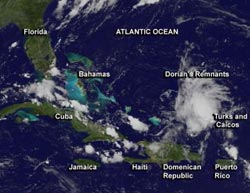Satellite shows ex-Tropical Storm Dorian's remnants elongated

NOAA's GOES-13 satellite captured this image of Dorian's remnants on July 30 at 10:15 a.m. EDT that showed showers and thunderstorms associated with Dorian's remnants north of Hispaniola.<br><br>Credit: NASA's GOES Project<br>
NOAA's GOES-13 satellite has been capturing images of the movement of Dorian since it was born. NASA's GOES Project at the NASA Goddard Space Flight Center in Greenbelt, Md. created an image of the storm using GOES-13 satellite data on July 30 at 1415 UTC/10:15 a.m. EDT. Dorian's remnants appear elongated from north to south on the GOES-13 image. The showers and thunderstorms are disorganized and extend a few hundred miles east and northeast of the Turks and Caicos Islands.
The National Hurricane Center or NHC noted that upper-level winds are not expected to favor re-development over the next couple of days, as Dorian's remnants move west to northwest. The remnant low is moving 10 to 15 mph, and is expected to bring showers and gusty winds across Turks and Caicos as it moves into portions of the Bahamas.
The NHC gave Dorian's remnants a 20 percent chance for regeneration over the next couple of days.
Media Contact
More Information:
http://www.nasa.govAll latest news from the category: Earth Sciences
Earth Sciences (also referred to as Geosciences), which deals with basic issues surrounding our planet, plays a vital role in the area of energy and raw materials supply.
Earth Sciences comprises subjects such as geology, geography, geological informatics, paleontology, mineralogy, petrography, crystallography, geophysics, geodesy, glaciology, cartography, photogrammetry, meteorology and seismology, early-warning systems, earthquake research and polar research.
Newest articles

Superradiant atoms could push the boundaries of how precisely time can be measured
Superradiant atoms can help us measure time more precisely than ever. In a new study, researchers from the University of Copenhagen present a new method for measuring the time interval,…

Ion thermoelectric conversion devices for near room temperature
The electrode sheet of the thermoelectric device consists of ionic hydrogel, which is sandwiched between the electrodes to form, and the Prussian blue on the electrode undergoes a redox reaction…

Zap Energy achieves 37-million-degree temperatures in a compact device
New publication reports record electron temperatures for a small-scale, sheared-flow-stabilized Z-pinch fusion device. In the nine decades since humans first produced fusion reactions, only a few fusion technologies have demonstrated…





















